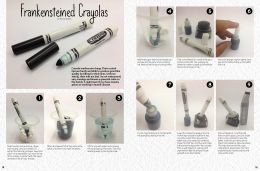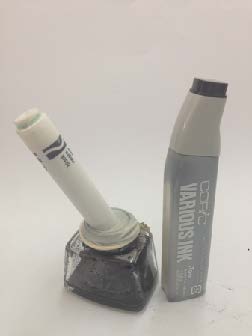Frankensteined Crayolas
 Page 18-19 | |
| Author | Kamal Dollah |
|---|---|
| Subject | How-To |
| Genre | Article |
| Published | EF Issue 2015.1 |
Publication date | Winter 2015 |
| Media type | Digital, |
| Pages | 18-20 |
| Website | caricature |
A step-by-step guide on how to fill Crayola markers with Copic ink, by Kamal Dollah, WInter 2015, pages 18-20.
Contents
Article Transcript
Crayola markers are cheap. Their conical tips are hardy and able to produce good line quality by tilting for thick lines. Unfortunately, their inks are bad. Its not waterproof, very smudgy and leaves a greenish stain on the hands. A nightmare if you have sweaty palms or working in humid climate.
Step 1
Skip this step and go to step 5 if you have empty, used up markers. To extract the bad ink, get paper towel and place it in a disposable cup. Have the tip of the marker in contact with the towel and leave it for an hour at least.
Step 2
When the towel is full of ink, replace the towel until there is no more ink stains.
Step 3
Fill the cup with water and immerse the tip to soak up the water. This is for washing away remaining bad inks.
Step 4
Add fresh paper towel to an empty cup to draw out the water and remaining ink. Notice that the tip is turning white.
Step 5
Find a small bottle or container for your preferred ink refill. Use a sponge to allow the marker to soak up ink without having it immersed in ink.
Step 6
Insert the sponge into the bottle. Best you do this before filling up the bottle with ink.
Step 7
The tip need to only be in contact with the sponge to draw out the ink.
Step 8
Leave the markers to soak up the ink. Half an hour should be sufficient. You can either watch the ink level in the bottle reduce or weigh the marker to know if it is full. You can fill up with Copic ink or whatever you prefer. You can also fill it up with inkjet ink. Load up with pigmented inkjet ink and you’ve got yourself an archival marker.
Step 9
Place a balloon or cut a fingertip from a rubber glove, puncture a hole in the center and place it over the bottle. Insert the pen through the hole in the balloon or glove as shown. This helps prevent the ink, especially solvent-based Copic ink, from evaporating during the process and reduces the smell.
Step 10
If you have a precision weighing scale, you will note that a brand new Crayola marker without its cover weights 9.4g, with the cover about 12g. If you are filling by sucking up the ink, you will not run the risk of over filling your marker. Overfilling can cause drips.
Step 11
Use lighter fluids to clean your marker if you are using solvent-based Copic ink.
Other Refill Options
OPTION 1. Drill a hole at the back to match a silicone plug size. The plugs may be difficult to find or purchase. I got mine from used ink jet printer cartridges.
OPTION 2. Use a syringe. Inject ink from the side of the tip where there is a little groove. To get a full load from empty requires 3cc/ml. Note: If you load with Copic ink, it will start to leak or the tip will harden after a while. Once this happens, it is time to replace the marker.
OPTION 1A. This makes refilling much faster; however, you must be careful not to overfill as it will leak. Have the cap on when doing this and give it some time for the sponge to absorb the ink.
Crayola also produces refillable clear markers, sold as the “Marker Maker Refill Pack.” You can bypass all the hassle of emptying the markers if you can get your hands on it.
Kamal Dollah is a Singaporean member of ISCA. He is founder of Cartoon.SG, a caricature specialty art studio and operates the caricature concession at Universal Studios Singapore. He is currently President of the ISCA Singapore chapter and is planning a minicon In June of 2015.
This Navigation box may not show up on mobile browsers. Please see Exaggerated Features Issue 2015.1 for the full contents of this issue if the navigation box does not display.




